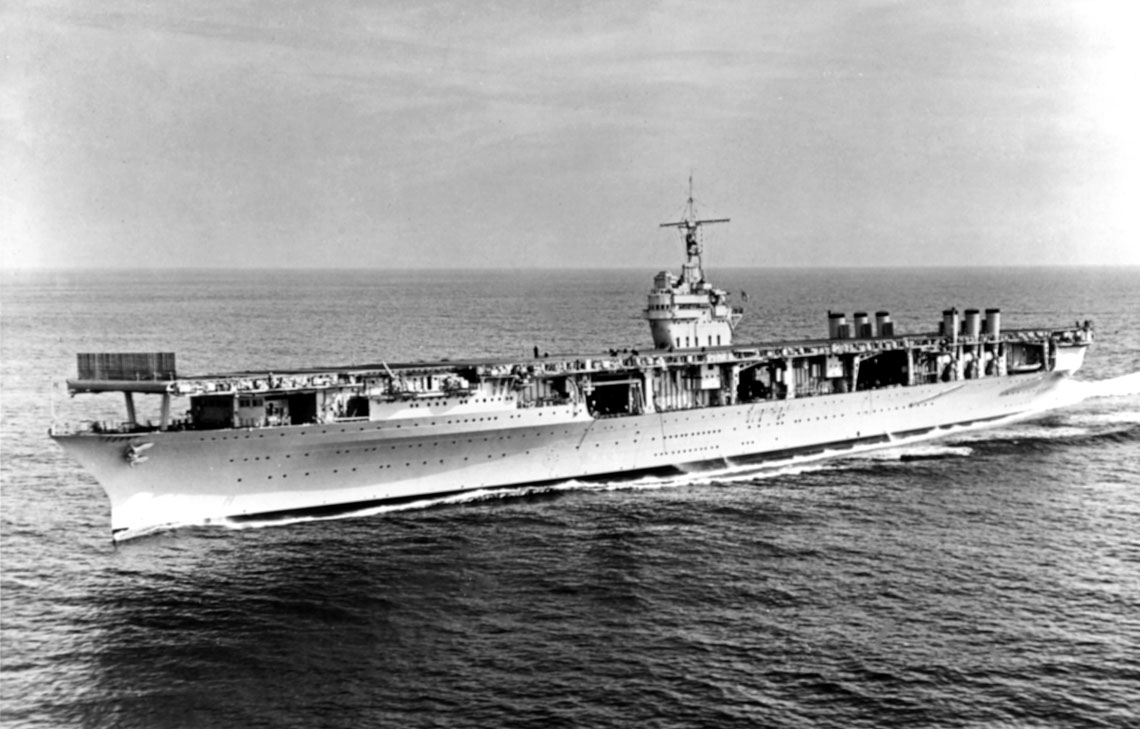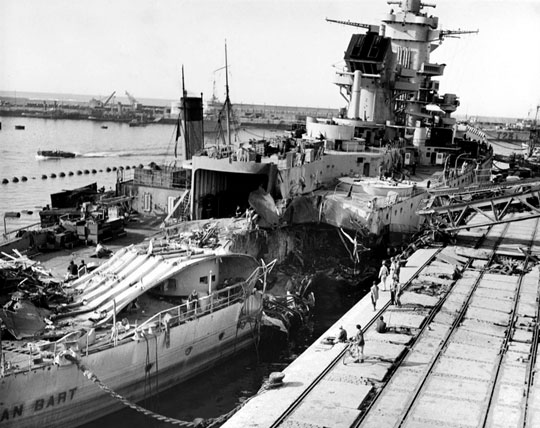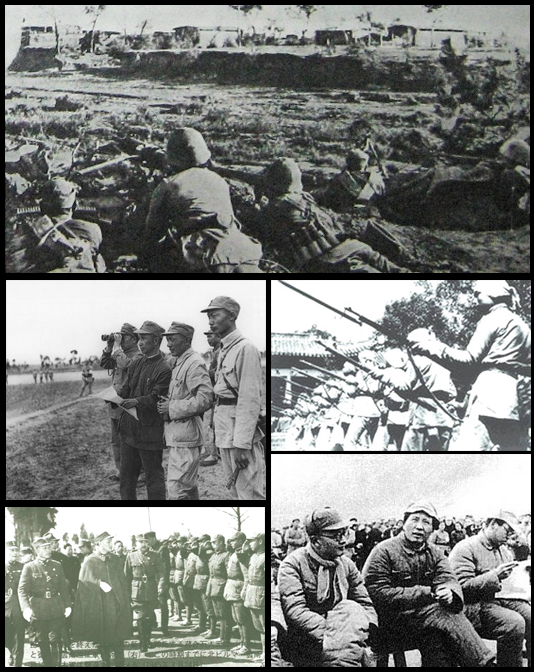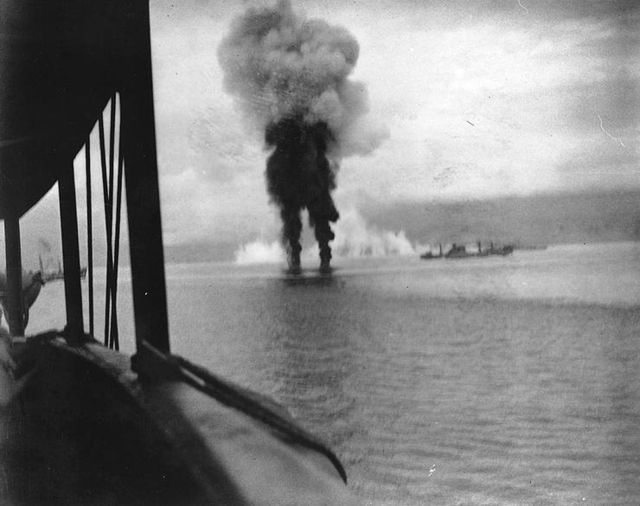
Ranger and "Leader"

Ranger in the late 30s. Aircraft remain in the hangar, so the ship's pipes are in a vertical position.
The presence of the heavy ships of the Kriegsmarine in northern Norway forced the British to maintain a fairly strong state at the base of the Scapa Flow home fleet. Since the spring of 1942, they could additionally "borrow" parts of the US Navy, and a few months later they again turned to Washington for help, this time asking to send an aircraft carrier. The Americans helped their allies with the help of a small, oldest Ranger, whose planes attacked German ships near Bodø in October 1943 with great success.
Two months earlier, the aircraft carrier Illustrious had been sent to the Mediterranean to aid the invasion of mainland Italy, with only the old Furious left in the home fleet in need of repairs. The response to the Admiralty's request was to send Task Force 112.1 to Scapa Flow, formed from Ranger (CV-4), the heavy cruisers Tuscaloosa (CA-37) and Augusta (CA-31) and 5 destroyers. This squadron arrived at the base in Orkney on 19 August and Cadmius, who was waiting there, took command. Olaf M. Hustvedt.
The Ranger was the first US Navy aircraft carrier designed from the outset as a ship of this class, rather than being converted from a ship (like the Langley CV-1) or an unfinished battlecruiser (like the Lexington CV-2 and Saratoga). resume-3). For the first four years of his service, based primarily in San Diego, California, he participated in the routine "Battle Force" exercises (Pacific part of the US Navy) with an air group initially consisting of 89 aircraft, only biplanes. Since April 1939, it was based in Norfolk (Virginia), after the outbreak of World War II, it first conducted exercises in the Caribbean, then the air group of the Wasps under construction (CV-7) trained there. In May 1941, after repairs, during which, among other things, anti-aircraft weapons were strengthened, the first so-called. Neutrality patrol consisting of the heavy cruiser Vincennes (CA-44) and a pair of destroyers. After her second patrol in June, she underwent further changes in equipment (including radar and radio beacon) and armament. In November, with a pair of cruisers and seven US Navy destroyers, he escorted transports carrying British soldiers from Halifax to Cape Town (convoy WS-24).
After Pearl Harbor, the Bermuda-based ship was used for training, with a break to patrol off Martinique to "guard" Vichy ships in late February 1942. After further equipment and armament modifications (late March/early April), she proceeded to Quonset Point ( south of Boston), where he took on board 68 (76?) Curtiss P-40E fighters. Accompanied by several destroyers through Trinidad, she reached Accra (British Gold Coast, now Ghana) on May 10, and there these machines, which were supposed to reach the front in North Africa, left the ship (they took off in groups, it took almost a full day). On July 1, after a period of basing in Argentina (Newfoundland), he called at Quonset Point for another batch of Curtiss P-40 fighters (this time 72 version F), which took off in Accra 18 days later.
Once again finalizing anti-aircraft weapons, after training near Norfolk, the Ranger took on board an air group of fighter squadrons VF-9 and VF-41 and bomber and observation squadrons VS-41, which trained most of October in Bermuda. The training preceded his participation in the Allied landings in the French part of North Africa (Operation Torch). Together with the escort aircraft carrier Suwanee (CVE-27), the light cruiser Cleveland (CL-55) and five destroyers, he formed Task Force 34.2, part of Task Force 34, tasked with covering and supporting the landing force that was to take Morocco. When he reached 8 nautical miles northwest of Casablanca before dawn on November 30, his air group had 72 combat-ready aircraft: one command aircraft (it was a Grumman TBF-1 Avenger torpedo bomber), 17 Douglas SBD-3 Dauntless dive bombers (VS-41) and 54 Grumman F4F-4 Wildcat fighter (26 VF-9 and 28 VF-41).
The French surrendered on the morning of November 11, 1942, by which time Ranger planes had taken off 496 times. On the first day of hostilities, fighters shot down 13 aircraft (including by mistake RAF Hudson) and destroyed about 20 on the ground, while the bombers sank the French submarines Amphitrite, Oread and Psyche, damaged the battleship Jean Bart , the light cruiser Primaguet and the destroyer Albatros. The next day, the Wildcats received 5 hits (again with their own machines), and at least 14 aircraft were destroyed on the ground. On the morning of November 10, the torpedoes fired by the Le Tonnant submarine at the Ranger missed. he settled his stern at the bottom of the pool in which he was moored. These successes had their price - as a result of enemy skirmishes and accidents, 15 fighters and 3 bombers were lost,
six pilots were killed.
After returning to Norfolk and inspecting the dock on January 19, 1943, the Ranger, accompanied by the Tuscaloosa and 5 destroyers, delivered 72 P-40 fighters to Casablanca. The same batch, but in version L, was released on February 24th. From the beginning of April until the end of July, he was based in Argentina, on the island of Newfoundland, making training trips along the surrounding waters. During this period, she briefly came under the spotlight of the media, as the Germans announced that she had been sunk. This was the result of an unsuccessful submarine attack - on April 23, U 404 fired four torpedoes at the British escort aircraft carrier Beater, their emissions (most likely at the end of the run) were perceived as a sign of hit and CP. Otto von Bülow reported sinking a misidentified target. When German propaganda trumpeted the success (Hitler awarded von Bülow the Iron Cross with Oak Leaves), the Americans, of course, could prove that this was nonsense, and called the submarine commander a lying coward, also delusional (under his command of U-Boat 404 many times bravely attacked convoys, sinking 14 ships and the British destroyer Veteran).
In the first ten days of August, the Ranger went to sea to escort the Queen Mary ocean liner, on which the British government delegation headed by Prime Minister Winston Churchill was heading to Quebec for a conference with the Americans. When 11 tm. left the Canadian airport, its air group (CVG-4) consisted of 67 aircraft: 27 FM-2 Wildcats belonging to the squadron VF-4 (ex-VF-41), 30 SBD Dauntless VB-4 (ex-VB-41, 28 in the variant 4 and two "triples") and 10 Grumman TBF-1 Avenger VT-4 torpedo bombers, one of which was the "personal" aircraft of the new group commander, Commander V. Joseph A. Ruddy.

Damage to the stern of the French battleship Jean Bart, moored in Casablanca. Some of them were caused by bombs dropped by Ranger planes.
The beginnings
More than 21 years earlier, in February 1922, representatives of the five world powers signed in Washington a treaty on the reduction of naval armaments, introducing "holidays" in the construction of the heaviest ships. To prevent the finished hulls of the two Lexington-class battleships from reaching the shipyards for demolition, the Americans decided to use them as a "chassis" for aircraft carriers. Ships of this class were subject to a full standard displacement limitation, which in the case of the US Navy was 135 tons. Since it was assumed that Lexington and Saratoga were 000 people each, 33 people were available.
When in Washington they began to think about a ship that would be an aircraft carrier from the moment the keel was laid, the first design “fitting”, in July 1922, included sketches of units with a design displacement of 11, 500, 17 and 000 tons. This meant differences in maximum speed, booking and size of the air group; in terms of armament, each option assumed the presence of 23-mm (000-27) guns and 000-mm (203 or 6) universal guns. In the end, it was decided that a minimum of 9 tf would bring a satisfactory result, for which it would be necessary to choose high speed and strong armament or high lower speed, but with strong armor, or many more aircraft.
In May 1924, there was a chance to include the aircraft carrier in the next US Navy expansion program. It turned out then that the Bureau of Aeronautics (BuAer), responsible for the qualitative and quantitative development of aviation, would prefer a ship with a smooth deck, without a superstructure on board (islands). Due to this, the larger air group and safer landings meant many problems, for example, with the placement of weapons. Members of the General Council, an advisory body under the Minister of the Navy composed of senior officers, also argued about the proper speed of the ship (taking into account the potential threat from the "Washington" cruisers) and its range. The Council ultimately proposed two options: a lightly armored, fast (32,5 in) ship with eight 203 mm guns and 60 aircraft, or a better armored but much slower (27,5 in) ship.
and with 72 aircraft.
When it turned out that funds for an aircraft carrier would not be included in the budget until 1929, the topic "fell off the list." He returned a dozen or so months later, at which time the Council voted in favor of a much smaller unit, excluding the 203 mm guns and the previously proposed armor. Although there were reports from London of problems with smoke removal on the Fast and the Furious and no problems with the Hermes and Eagle, both with islands, BuAer continued to opt for a sleek flight deck. In February 1926, specialists from the Bureau of Construction and Repair (BuSiR) presented sketches of units with a displacement of 10, 000 and 13 tons, which were supposed to reach 800-23 cm. The smallest of them did not have an armored side belt, armament in its hull consisted of 000 32-mm guns. The other two had side stripes 32,5 mm thick, and a dozen had 12 127 mm guns.
At a meeting of the Council in March 1927, the head of the BKR voted for a medium-sized ship, on the basis that five such units account for the total area of \u15b\u20baircraft decks 23-000 percent. more than in the case of three with a displacement of 20 tons. They could have “useful” hull protection, but calculations showed that armor on the deck of the aircraft or protection of the hangar was out of the question. Due to such low resistance to combat damage, and hence the high probability of losses, more ships were better. However, there is the issue of costs, which are about 80 percent higher. due to two additional expensive engine rooms. When it came to the features needed for the BuAer, it was decided that the flight deck should be at least 24,4 feet (665 m) wide and approximately 203 (XNUMX m) long with brake line systems and catapults at both ends.
At a meeting in October, the officer representing the pilots spoke in favor of a ship with a displacement of 13 tons, which would accommodate 800 bombers and 36 fighters in the hangar and on board, or - in the version with a higher maximum speed (72 instead of 32,5 knots) - 29,4 and 27 respectively. While the advantages of the island had already been seen (as a landing guide, for example), the smoothness of the deck was still considered "highly desirable". An exhaust gas problem forced the Bureau of Engineering (BuEng) to opt for an island, but since the cost of the ship was determined by the advantages of the "airport", BuAer got it.
The start of operation of the Saratoga and Lexington (the first officially entered service two weeks earlier, the second in mid-December) meant that on November 1, 1927, the Main Council proposed to the secretary to build five at 13 tf. Since, contrary to the opinion of specialists from the Department of War Plans, who wanted them to form connections with the Washington cruisers, their interaction with the then "slow" battleships was envisaged, the new aircraft carriers were considered unnecessary for the passage through the 800th century.
Other alternatives were considered at BuC&R over the next three months, but only four design sketches for the 13-ton ship were taken to a more advanced stage, and the Board chose the 800-foot (700 m) flight deck option. Since the designers recognized that even the tall chimneys on the island might not disturb the air above it, the requirement for smoothness was maintained. In this situation, in order to keep deck smoke as low as possible, the boilers had to be located as close as possible to the end of the hull, and as a result, it was decided to locate the boiler room “unorthodoxly” behind the turbine compartment. It was also decided, as on the experimental Langley, to use folding chimneys (their number increased to six), which allowed them to be placed horizontally, perpendicular to the sides. During air operations, all exhaust gases could be directed to a "located" symmetrical trio located on the leeward side.
Moving the engine room aft precluded its greater weight (causing severe trim problems) and therefore power, so the Board finally approved 53 hp, which was to give a top speed of 000 knots under test conditions. It was also decided that the air group should have 29,4 vehicles (including only 108 bombers and torpedo bombers), and two catapults should be installed on the hangar deck, across the fuselage. Serious changes were made to weapons - as a result, anti-submarine guns, torpedo tubes and guns were abandoned in favor of a dozen 27-mm L / 127 universal guns and as many 25-mm machine guns as possible, with the requirement to install them outside the flight deck and provide them to everyone trunks as large fields of fire as possible. Calculations showed that only a few tens of tons of armor would remain, and, finally, the steering mechanism was covered (plates 12,7 mm thick on the sides and 51 mm on top). Since it was not possible to properly fix the warheads, torpedoes were abandoned, and airborne aircraft were to be armed only with bombs.

